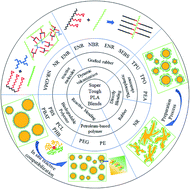Super tough poly(lactic acid) blends: a comprehensive review
Abstract
Poly(lactic acid) or poly(lactide) (PLA) is a renewable, bio-based, and biodegradable aliphatic thermoplastic polyester that is considered a promising alternative to petrochemical-derived polymers in a wide range of commodity and engineering applications. However, PLA is inherently brittle, with less than 10% elongation at break and a relatively poor impact strength, which limit its use in some specific areas. Therefore, enhancing the toughness of PLA has been widely explored in academic and industrial fields over the last two decades. This work aims to summarize and organize the current development in super tough PLA fabricated via polymer blending. The miscibility and compatibility of PLA-based blends, and the methods and approaches for compatibilized PLA blends are briefly discussed. Recent advances in PLA modified with various polymers for improving the toughness of PLA are also summarized and elucidated systematically in this review. Various polymers used in toughening PLA are discussed and organized: elastomers, such as petroleum-based traditional polyurethanes (PUs), bio-based elastomers, and biodegradable polyester elastomers; glycidyl ester compatibilizers and their copolymers/elastomers, such as poly(ethylene-co-glycidyl methacrylate) (EGMA), poly(ethylene-n-butylene-acrylate-co-glycidyl methacrylate) (EBA-GMA); rubber; petroleum-based traditional plastics, such as PE and PP; and various biodegradable polymers, such as poly(butylene adipate-co-terephthalate) (PBAT), polycaprolactone (PCL), poly(butylene succinate) (PBS), and natural macromolecules, especially starch. The high tensile toughness and high impact strength of PLA-based blends are briefly outlined, while the super tough PLA-based blends with impact strength exceeding 50 kJ m−2 are elucidated in detail. The toughening strategies and approaches of PLA based super tough blends are summarized and analyzed. The relationship of the properties of PLA-based blends and their morphological parameters, including particle size, interparticle distance, and phase morphologies, are presented.

- This article is part of the themed collections: Renewable materials and recycling and 2020 Reviews in RSC Advances


 Please wait while we load your content...
Please wait while we load your content...